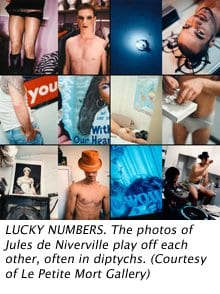Between 1996 and 1997, Montreal photographer Jules de Niverville went to New York at the urging of Guy Bérubé. The result was a year of inspired photographs of the mostly underground culture of the gay men working in the sex trade.
“I had already been photographing the stars of the underground in Montreal — performers, drag queens, bartenders, dancers, porn stars,” de Niverville says. “I kind of was interested in continuing in that vein in New York.”
While his initial focus wasn’t on hustlers, de Niverville was quickly stuck by its prevalence among new arrivals to the city.
“It was almost like a rite of passage in certain circles, especially more underground performance artists,” he says. “It was a way of showing that you could completely dissociate your sex from emotion, your self from your body. I think for a lot of people they used it as a tool to influence their art and influence their form. For others it was just part and parcel of the trip there — the drugs and the nightlife and having to pay for it.”
The show is presented as diptychs — two images set side by side. In this case, they are usually presented as one of the subjects on one side, their homes or environments on the other.
“I was shooting mostly in their homes — very, very tight little environments,” de Niverville says. He also took cues from their props, since most of the subjects were avid collectors of something.
“I was also drawn to the neighbourhood in which most of them were living — the ones I was interested in anyway — which was the Lower East Side and East Village,” de Niverville adds. The period was a transitory time in New York. Residents were reclaiming vacant lots where abandoned buildings had been demolished, turning them into little gardens.
“I just thought it was an interesting thing to record, and I felt that definitely having the images paired, both of them just sort of feed off each other,” he says. “It creates a total portrait of not only their homes but the type of environment they were in.”
By showing their environments, de Niverville contrasts the seductive glamour of New York with the realities of their situations.
“There’s a lonely quality to them,” he says. “It’s not being partying and joyous and all like that. I’d spend 12 to 48 hours with them, and just gradually take pictures of them, and I’d visit them two or three times over that two year period. It wasn’t so much about the partying as much as the relics of the lifestyle.”
Most significantly for de Niverville, the images touch on identity and adaptability.
“It’s the outside of culture, living on the fringe of convention, the gay identity or other,” he says. “It’s just people searching for their senses of selves in a situation where we don’t fit in in traditional ways, and the struggle that that entails, and the learning curve that that fits in, and that’s what I empathize with mostly in the kind of portraiture.”


 Why you can trust Xtra
Why you can trust Xtra


